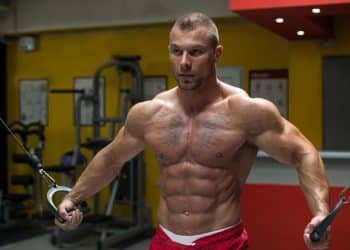I posed a question recently in a round table discussion and that question was: Is training to failure necessary to build muscle mass? My response was yes, of course. How can a muscle grow unless you progressively ask more of it and training to failure is a very good way of doing just that. You are training to the very limit of your muscles capabilities and therefore your muscle will respond by growing stronger. Then I got curious. Is that really how it works? Maybe that’s just what makes sense to me but not necessarily what actually is the case. Today I’m going to begin digging deeper into the question I actually asked myself again: Is training to failure necessary for muscle hypertrophy?
The reasons are many as to why myself, and many others think that training to failure is necessary to stimulate new tissue growth. By doing so the muscle will undergo micro tearing and training to the point of ischemic rigor, where the muscle will begin to lock up (think rigor mortis) and undergo tearing during the eccentric (negative) phase of the lift, and this is the stimulus for growth. This has been shown to be relatively effective as a method of growth however as negative only training has produced great results in many studies (1-14). The combination of both eccentric and concentric contractions is superior, but there is no doubt that the eccentric portion of the lift appears to be the more important of the two by a sizable margin when it comes to growing your muscles.
That much we can agree on at this point. Heavy training that emphasizes the eccentric portion of the lift cause a marked increase in biochemical markers of muscle damage which would lead one to believe that muscle damage is the stimulus for growth. Then if that is all true, how much muscle damage needs to occur in order for muscle growth to occur. It will happen even if we train nowhere near to failure, if the reps are high enough (5 or 6 and up for argument’s sake as to the minimum amount of reps required for muscle damage to begin). This, however, has yet to be determined. I’m going to state the obvious, as we who wrote about this type of thing unfortunately always have to do whenever this subject of training and muscle growth come up: genetics. Some respond well to high volume training and some to lower volume.
That complicates the answer to the main question of this article even further, as each individual will respond differently to the stimulus that they are challenged with. This means that there is no magic number of reps that we can declare that causes muscle growth, even though it appears to be rather obvious. This lack of proof defining what it is that causes muscle growth have prompted others to theorize that ATP (adenosine tri phosphate) depletion , CP (creatine phosphate) depletion, decreased blood flow as the result of near maximal muscular contractions, increased blood flow, muscle ischemia (oxygen deprivation) and the tension/metabolic work theory(15) that argues that forcing the muscles to work at high intensities is the key for stimulating muscle growth. That’s a whole lot of theories, including training to failure that could be responsible for muscle growth.
Then what makes training to failure the most often cited training method to employ to ensure muscle growth? The micro tear theory is a good one, except when we see that studies having subjects run downhill also caused the same type of micro tearing and running has never been very good at building muscle mass.
Level Up Your Fitness: Join our 💪 strong community in Fitness Volt Newsletter. Get daily inspiration, expert-backed workouts, nutrition tips, the latest in strength sports, and the support you need to reach your goals. Subscribe for free!
If you were to lift a weight that would recruit 100 percent of your motor units, meaning 8 reps for upper body and 25 reps for lower body, then those who support the theory that muscle failure must be reached in order to stimulate hypertrophy say that you must lift that 8th rep. If you only lifted 7 reps of a load that you were capable of lifting 8 reps then you would still reach ATP and CP depletion, decreased blood flow, increased blood flow, oxygen deprivation and a long enough time under tension. So was that last rep to failure necessary when all of the above possible markers for muscle growth were reached?
That’s as far as I’m taking this introductory exploration into the possible reasons for muscle growth that may or may not include training to failure. Next time I would like to look further into time under tension, as that has always been an assumed necessary ingredient for stimulating new muscle mass and what relationship if any that has with reaching failure. Included in that discussion will be the issue of rep speed, which is one thing I haven’t touched on at all. I promise you this adds up to some very interesting arguments for and against training to failure. At some point in this series I hope to be able to give you a definitive answer, but with so many theories abounding, who knows if there even is an answer. (editors note – insert winky face here) Until next time my friends,
Happy Lifting!
References
- Sheppard, J., Young, K. Using Additional Eccentric Loads to Increase Concentric Performance in the Bench Throw. Journal of Strength and Conditioning Research. 2010. 24(10), 2853-2856.
- Raj, I., Bird, S., et al. Effects of Eccentrically Biased Versus Conventional Weight training in Older Adults. Medicine and Science in Sports and Exercise. December 2011. Published ahead of Print.
- O’Sullivan, K., McAuliffe, S., et al. The Effects of Eccentric Training on Lower Limb Flexibility: A Review. British Journal of Sports Medicine. 2012. Published Ahead of Print.
- Chen, T., Chen, H., et al. Attenuation of Eccentric Exercise-Induced Muscle Damage by Preconditioning Exercises. Medicine and Science in Sports and Exercise. 2012. Published Ahead of Print.
- Schoenfeld, Brad. The Use of Specialized Training Techniques to Maximize Muscle Hypertrophy. Strength and Conditioning Journal. August 2011. 33(4), 60-65.
- Schoenfeld, Brad. The Mechanisms of Muscle Hypertrophy and Their Application to Resistance Training. Journal of Strength and Conditioning Research. October 2010. 24(10), 2857-2872.
- Leal, M., Lamas, L., Aoki, M., Ugrinowitsch, C., Sorelli, M., et al. Effect of Different Resistance-Training Regimens on the WNT-Signaling Pathway. European Journal of Applied Physiology. 2 March 2011. Published Ahead of Print.
- Sheppard, J., Young, K. Using Additional Eccentric Loads to Increase Concentric Performance in the Bench Throw. Journal of Strength and Conditioning Research. 2010. 24(10), 2853-2856.
- Beaven, C., Gill, N., Ingram, J., Hopkins, W. Acute Salivary Hormone Responses to Complex Exercise Bouts. 2011. Journal of Strength and Conditioning Research. 25(4), 1072-1078.
- Muscle Adaptations to Resistance Training. 1991. Acta Physologica Scandinavia. 143(2), 177-185.
- Hortobagyi, T., Dempsey, L., et al. Changes in Muscle Strength, Muscle Fiber Size and Myofibrillar Gene Expression after Immobilization and Retraining in Humans. The Jordan of Physiology. 2000. 524(1), 293-304.
- Petersen, J., Thorborg, K., et al.. Preventive Effect of Eccentric Training on Acute Hamstring Injuries in Men’s soccer. American Journal of Sports Medicine. 2011. 39(11), 2296-2303.
- Schache, A. Eccentric Hamstring Muscle Training Can Prevent Hamstring Injuries in Soccer Players. Journal of Physiotherapy. 2012. 58(1), 58.
- Cowell, J., Cronin, J., et al. Eccentric Muscle Actions and How the Strength and Conditioning Specialist Might Use Them for a Variety of Purposes. Strength and Conditioning Journal. 2012. 34(3), 33-48.
- Seminal Review Article by Goldspink et. al.








